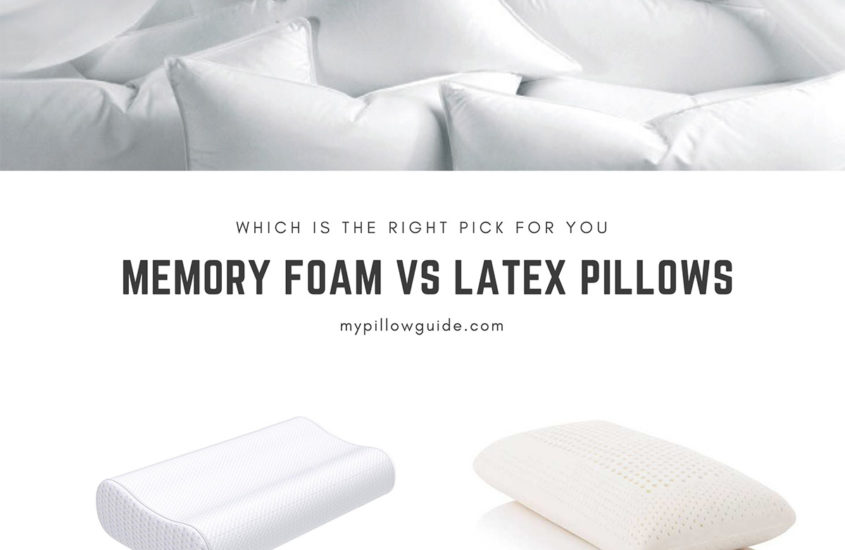Memory Foam vs Latex Pillows: Which Is the Right Pick for You?

Did you know that the world’s first pillows were made from stone?
Fortunately, we’ve come a long way since then. Nowadays, spoilt for choice, we have dozens of different pillow types on the market—each with its own pros and cons.
Two of which are latex pillows and memory foam pillows. Latex pillows were invented during the time that rubber was made from latex sap. Memory foam, interestingly, was developed in the 1960s by NASA after which it was tested in pillows and mattresses.
If you are like I was (totally confused about the difference between these two pillows), then read on. I have the detailed scoop on both of these pillow options!
Memory Foam Pillows

Memory foam pillows have burgeoned in popularity, thanks to their supportive properties. Many people with neck and joint pain opt for these pillows.
Memory foam is constructed out of viscoelastic polyurethane. Designed to be an innovative material, it has a number of unique properties. After its conception in space research, it was then utilized in wheelchairs and post-surgery padding applications.
Memory foam is unique in that it molds to your form. It has a heavy feel and allows you to slowly sink into the foam while at the same time, it offers superior levels of support.
Hard to the touch at first, memory foam quickly softens with exposure to body heat. This allows it to take the shape of your head, neck, or body. Once pressure is released, it keeps its depressions for a few seconds, after which it slowly resumes its original form.
Pros
The biggest benefits of memory foam pillows have to be their ability to hold the contours of the head and neck, distribute weight evenly, and relieve pressure on joints.
For these reasons, memory foam pillows are often used to ease the symptoms of neck, back, and joint pain.
Memory foam pillows are also resistant to dust mites, come in a wide range of price points, and never need to be fluffed up.
Lastly, do you sleep with a restless partner? Hands up if you’re with me! My boyfriend is a tosser and turner, and with me being a light sleeper, this can really impact my quality of sleep.
Fortunately, another perk of memory foam is that it cushions movements. Meaning that if you buy your other half a memory foam pillow, the ripple effect of their movements will be reduced.
Cons
Possibly the largest downside to memory foam is the fact that it holds on to heat and moisture. If you live in a warm country, or are traveling to one (like me!), there’s nothing worse than a pillow that stores all of your body heat and traps your sweat.
On the other hand, if you live in a cool climate, don’t sweat, and are happy to wash your memory foam pillows regularly, this might not be a problem.
The other cons of memory foam pillows are that they are synthetic (and can release fumes), they don’t last as long as latex pillows, and can feel hard to the touch.
Latex Pillows

Latex pillows were originally made from latex rubber. Latex is a natural substance harvested from the rubber tree.
The original latex pillows were made by pouring foamed sap into a mold. Once the rubber formed, small air bubbles would be left in the latex, resulting in a springy feel.
Nowadays, you can purchase latex pillows made from both natural latex and synthetic imitations. While the synthetic versions are not as long-lasting as real latex, they have an almost identical springiness.
This springy texture is the defining characteristic of latex pillows. Unlike memory foam pillows, they are soft to the touch and spring back easily. This gives them a more “regular” pillow feeling.
Pros
For one, they feel more like a regular pillow, while offering the same level of superior support that memory foam pillows do. If you’re put off by the heavy, sinking feeling of memory foam, then this can be a decided perk.
Another big pro of latex pillows is that they disperse heat and moisture much better than memory foam does. This means that your pillow will not build up heat, and it won’t become damp and heavy with moisture over time. If you’re a warm sleeper who sweats or hates overheating, then this is an important point to consider.
Real latex foam pillows are also longer-lasting than feather, down, synthetic fill, or memory foam pillows, provided you do proper latex pillow care.
Lastly, real latex pillows are inherently antifungal, hypoallergenic, and non-toxic, making them perfect for people who suffer from pillow allergies. Unlike memory foam, they’re not made from petroleum products, and therefore, do not release harmful off-gasses.
Cons
Although latex pillows do not produce off-gas toxins, they do smell in the beginning! Fortunately, this smell does go away.
Latex pillows offer superior levels of weight distribution and even more support than regular pillows. However, another potential drawback to latex foam pillows is that they’re considered less ergonomic than memory foam.
If you’re suffering from chronic back pain, weight distribution issues, or joint pain, then you might want to consider trying a memory foam pillow.
Additionally, some people suffer from latex allergies, which makes latex pillows highly unsuitable for them!
Lastly, from reviewing and investigating the different options out there, I’ve found that latex pillow types can get confusing! There are so many different construction types and blends that it can take a little while to figure out where the best value for money lies.
Oh! Speaking of value for money, I almost forgot. Real latex pillows can be on the pricey side. However, considering that they can last more than three times longer than memory foam pillows, this is not necessarily a drawback in the long term.
My Parting Tip: Order Both, Send One Back
Are you still not sure which pillow type you’d like? Choosing between memory foam and latex pillows can be tricky, especially if you’ve never tried either.
So instead, my advice: if you’re ordering online, get both. Try them out in the comfort of your own home. Once you’ve made your selection, return the one you’ve decided against.
You can thank me later, wink wink.
If you want more info on pillows and hate a hot sleep, you can also read my post on cooling pillows!



